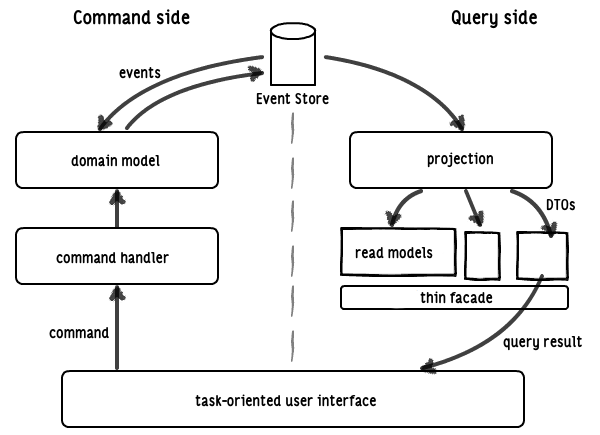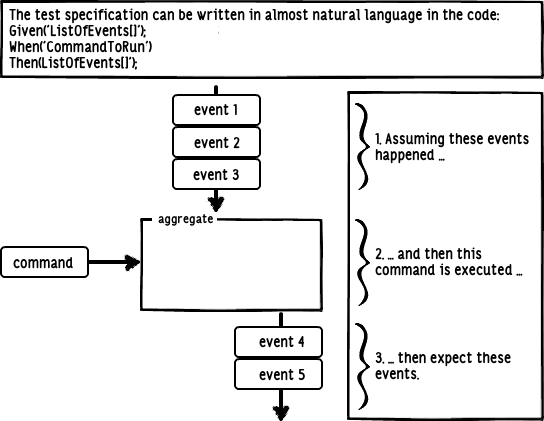- CQRS Journey: Free ebook from Microsoft (Print book available for purchase)
- Functional and Reactive Domain Modeling: A high level overview of how to build up domain models using free monads and interpreters.
- Reactive Microservices Architecture: Free booklet from Lagom and O'Reilly
- Reactive Messaging Patterns with the Actor Model: Applications and Integration in Scala and Akka
- Domain-Driven Design: Tackling Complexity in the Heart of Software
- The Reactive Manifesto
- CQRS Journey Reference 2: Introducing the Command Query Responsibility Segregation Pattern
- CQRS Journey Reference 3: Introducing Event Sourcing
- Microsoft Docs: Command and Query Responsibility Segregation (CQRS)
- Microsoft Docs: Event Sourcing
- Microsoft Docs: CRUD, Only When You Can Afford It
- Martin Fowler: Bounded Context
- Martin Fowler: CQRS
- Martin Fowler: Event Sourcing
- Lagom core concepts: Event Sourcing and CQRS
- Concept Map » CQRS And Event Sourcing
- The H: CQRS – a new architecture precept based on segregation of commands and queries
- Hyper Lambda: Eventflow - CQRS/ES in Haskell
- James Roper: CQRS increases consistency
- Confluent: Stream processing, Event sourcing, Reactive, CEP… and making sense of it all
CQRS, DDD and Event Sourcing are informally defined design patterns. It would be nice to see a precise, theoretical foundation for these ideas. This could help find the signal in the noise and reduce confusion for newcomers. Interstingly, akka-persistence is an implementation of event sourcing that seems quite similar to state machine replication. Aggregates in this instance corespond to PersistantActors.
- Vaughn Vernon: Modeling Aggregates with DDD and Entity Framework
- Kevin Webber: Modelling Reactive Systems with Event Storming and Domain-Driven Design
- Life Beyond Distributed Transactions: An apostate's opinion, Pat Helland
- CQRS Journey, Reference 6: A Saga on Sagas
- Sagas, Hector Garcaa-Molrna, Kenneth Salem - The original paper!
- Conflict-free Replicated Data Types, Marc Shapiro et al.
- A comprehensive study of Convergent and Commutative Replicated Data Types, Marc Shapiro et al.
- Evaluating CRDTs for Real-time Document Editing: Mehdi Ahmed-Nacer et al.
- "Consistency without consensus in production systems" by Peter Bourgon
- Readings in conflict-free replicated data types
- Learn Datalog Today - interactive tutorial designed teaching the Datomic dialect of Datalog
- BOOM Papers
- Consistency Analysis in Bloom: a CALM and Collected Approach Peter Alvaro et al.
- Bloom Language
- Bloom: Big Systems from Small Programs - RICON East 2013
- "I See What You Mean" by Peter Alvaro
Events and business rules map really nicely onto free monads and interpreters.
- http://www.stephenzoio.com/free-monads-and-event-sourcing/
- http://www.stephenzoio.com/free-monad-event-sourcing-interpreters/
- [Functional and Reactive Domain Modeling]
- https://fsharpforfunandprofit.com/category/DDD/
- http://lucasmreis.github.io/blog/type-driven-domain-modelling-part-1/
- http://lucasmreis.github.io/blog/type-driven-domain-modelling-part-2/
- http://lucasmreis.github.io/blog/type-driven-domain-modelling-part-3/
It can be a little hard to match up CQRS with traditional REST routes. There are a number of approaches I have seen mentioned, ranging from embracing RPC-style payloads to trying to translate CRUDful REST calls to commands.
- https://github.com/aliostad/m-r#readme
- https://www.slideshare.net/fatmuemoo/cqrs-api-v2 - this is the one I like the most!
- https://www.infoq.com/articles/rest-api-on-cqrs
- GraphQL seems like it might be a good fit for exposing CQRS
- https://github.com/sangria-graphql/sangria-subscriptions-example - example of using GraphQL
- Akka persistence: Schema Evolution
- The Dark Side of Event Sourcing: Managing Data Conversion, Michiel Overeem et al.
- https://speakerdeck.com/overeemm/the-dark-side-of-event-sourcing-managing-data-conversion
- Axon Framework: Event Upcasting
- Michiel Rook: Event versioning (or why I sometimes modify the event store)
- Migrating JSON with lens and foci
- slashdotdash/eventstore-migrator
- Haskell libraries
- CQRS Journey, Journey 6: Versioning Our System
- http://stackoverflow.com/questions/7065045/using-an-rdbms-as-event-sourcing-storage
- http://stackoverflow.com/questions/23438963/relational-database-schema-for-event-sourcing
- https://lostechies.com/gabrielschenker/2015/07/13/event-sourcing-applied-the-repository/
- https://github.com/dnvriend/akka-persistence-jdbc/blob/master/src/test/resources/schema/postgres/postgres-schema.sql
- https://cqrs.wordpress.com/documents/building-event-storage/
Datomic is a very interesting database! It splits the read side from the write side, and uses an append-only log for storing data. Unlike DDD-style event sourcing though, events don't correspond to domain events. Rather they are factual assertions that can be mapped to the more traditional 'CRUD' operations:
| CRUD | Datomic |
|---|---|
| Create | Assert |
| Read | Read |
| Update | Accumulate |
| Delete | Retract |
The nice thing about this is that it allows one to hook into a more powerful and flexible query language than SQL, Datalog, that allows you to do historical querying. There have been questions raised about Datomic's scalability though (citation needed), and the database is tightly coupled to Clojure.
Some reality checks:
- Udi Dahan: When to avoid CQRS: "Most people using CQRS (and Event Sourcing too) shouldn’t have done so."
- Dan McKinley: Choose Boring Technology
- InfoQ: A Whole System Based on Event Sourcing is an Anti-Pattern
- Some random person on HN: "I have worked on, or cleaned up, 4 different CQRS/ES projects. They have all failed. Each time the people leading the project and championing the architecture were smart, capable, technically adept folks, but they couldn't make it work."
-
C#
-
Clojure
- capitalone/cqrs-manager-for-distributed-reactive-services: Accompanies the Strange Loop talk, Commander: Better Distributed Applications through CQRS and Event Sourcing. Uses a single RPC-style
/commandsroute for submitting commands to the service.
- capitalone/cqrs-manager-for-distributed-reactive-services: Accompanies the Strange Loop talk, Commander: Better Distributed Applications through CQRS and Event Sourcing. Uses a single RPC-style
-
Elixir
- Building a CQRS/ES web application in Elixir using Phoenix
- slashdotdash/commanded: CQRS framework that like [lagom/lagom], uses a supervisor with actors for command enusuring commands for different aggregates can be handled in parallel while maintaining ordering. Unlike Lagom, it does not handle distributing writers across nodes, so therfore does not need to handle netsplit scenarios. Uses slashdotdash/eventstore for persistence.
- slashdotdash/commanded-audit-middleware
- slashdotdash/eventstore: CQRS event store using PostgreSQL for persistence
- slashdotdash/eventstore-migrator
- Building a CQRS/ES web application in Elixir using Phoenix
-
Haskell
- abailly/hevents: A very incomplete event sourcing library using extensible effects.
- jdreaver/eventful: A more fully fleshed out event sourcing library with both in-memory and SQLite event store implementations. Uses an
ExpectedVersiontype to attempt to protect against concurrency errors when multiple writers are accessing the event store. - Fristi/Aggregate.hs: A simple Gist showing an
Aggregatetype class with associated types for commands and events. - http://www.hyperlambda.com/posts/cqrs-es-in-haskell/
- https://abailly.github.io/posts/cm-arch-design.html#models
-
Java
-
Ruby
- sequent:
-
Rust
- Chronicle: An experimental CQRS+ES framework in Rust by yours truly! :)
-
Scala
- akka-persistence
- akka-ddd
- github
- examples: ddd-leaven-akka-v2
- Functional and Reactive Domain Modeling code examples
- Lagom: A reactive microservice framework built upon Akka persistence. Command ordering is enforced by having a single actor managing command handling for each aggregate instance.
- Eventuate: Event sourcing framework with CRDTs and eventual consistency. There are some excellent design documents on the website.



I was just made aware of a recently-updated version of Life Beyond Distributed Transactions.